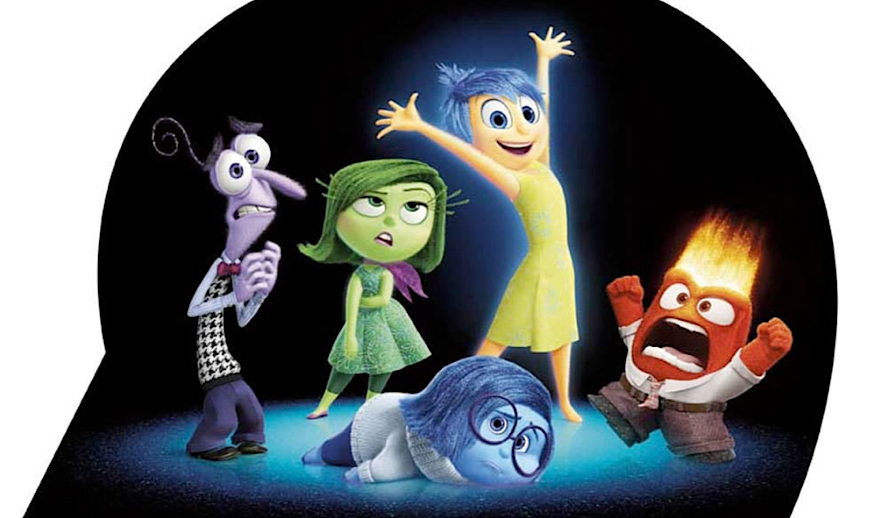Table of Contents

Photo: ‘Inside Out’/Pixar
This Christmas will see the release of the much anticipated Disney/Pixar animated film ‘Soul‘ on Disney+. And one of the things to look forward to is seeing how the film, which centers on the idea of what it is that makes us who we are, would depict abstract and metaphysical concepts like souls, the afterlife, and the formation of personalities. Such lofty goals are in line with ‘Soul’ writer-director Pete Docter’s past work at Pixar: his 2009 film ‘Up‘ opened with an emotionally powerful and devastating montage that encapsulated married life.
Related article: Must-Watch – ‘Soul’: Pixar Proves the Power of the Human Spirit in Newest Original Film
Related article: Pixar Drawing Tutorials: The Animation Studio Uses YouTube to Tackle Self-Isolation
Docter followed that up with the even more ambitious 2015’s ‘Inside Out‘, which explores through clever personifications how the human mind (in this case, that of a preteen girl) works. While that is the hook—the high concept that draws us in—Docter uses it as a springboard to convey his real message: that sadness is important in our lives. And as we approach the end of the year with an encroaching feeling of the blues, compounded by the unbearably difficult year 2020 has been, Inside Out’s message of emotional openness feels more important now.
A Quick Refresher on ‘Inside Out’
The film primarily takes place in the mind of eleven-year-old Riley (Kaitlyn Dias), whose happy life is upended when she and her family (Diane Lane and Kyle MacLachlan) move from their home in Minnesota to San Francisco. As Riley adjusts to her new surroundings, her inner struggle is personified through the emotions that control her: Joy (Amy Poehler), Fear (Bill Hader), Anger (Lewis Black), Disgust (Mindy Kaling), and Sadness (Phyllis Smith). Joy serves as the leader of the group, and while she sees value in the other emotions she’s unsure of what to do with Sadness and spends most of her time trying to limit Sadness’ influence.
Subscribe to Hollywood Insider’s YouTube Channel, by clicking here.
The story picks up when Sadness constantly finds herself interacting with Riley’s joyous memories (personified as colored orbs) and turning them sad. This doesn’t sit well with Joy and eventually, she and Sadness are accidentally ejected from their control center and deeper into Riley’s mind. As Fear, Anger, and Disgust try to maintain control of Riley (with disastrous results in the real world), Joy and Sadness try to find their way back. And by the end of their journey, Joy comes to see Sadness’ value in helping Riley become a fuller and more emotionally healthy person.
Joy and Sadness’ journey through Riley’s mind, with help from Riley’s long-lost imaginary friend Bing Bong (Richard Kind), results in some of the funniest and most imaginative visuals in a Pixar film. There’s a great deal of humor and excitement in seeing how the film depicts concepts like imagination, abstract thought, the subconscious, and how dreams are made; they even explain how and why annoying songs get stuck in one’s head. But while the film is extremely entertaining, that’s not all it has to offer; every movie has something to say about the human condition. And while it is simplified to make things easier for children and general audiences to follow, Inside Out has some astute things to say about emotions. There’s something to be said for a movie that could help kids grasp the complex emotions going through their heads.
Related article: The Power of Positivity: Ikorodu Bois + Chris Hemsworth + Russo Brothers + Sam Hargrave
Limited Time Offer – FREE Subscription to Hollywood Insider
The Moral of the Story: Sadness is Key
(some spoilers follow for Inside Out)
As mentioned earlier, Joy doesn’t see Sadness’ value and when the two are stranded in the depths of Riley’s mind, Joy feels Sadness is just slowing them down. But there’s a turning point midway through the movie when Bing Bong (who’d been guiding them) suffers a loss and is devastated. Joy tries everything to cheer him up but nothing works. It’s not until Sadness sits down with him; she listens to him and empathizes with his loss. In letting it out, he finds catharsis and snaps out of his sorrow ready to help them again.
It takes a while for Joy to catch on to the lesson. When she sees a chance to quickly return to the control center, Joy reluctantly abandons Sadness out of the belief that Riley desperately needs to be happy only to be stranded even further. As she falls into despair, Joy notices that one of Riley’s happy core memories only came about as a result of a sad one, and it clicks: Sadness lets other people know when Riley is hurting, which then drives people to help her.
Related article: Hollywood Insider’s CEO Pritan Ambroase: “The Importance of Venice Film Festival as the Protector of Cinema”
Related article: The Masters of Cinema Archives: Hollywood Insider Pays Tribute to ‘La Vie En Rose’, Exclusive Interview with Director Olivier Dahan
As Riley becomes apathetic and nearly runs away from home, Joy and Sadness finally make their way back to the control center and Joy lets Sadness take over. Riley returns home and breaks down in front of her parents and tearfully shares her fears and worries; her parents admit they feel the same way she does and comfort her. Like the earlier scene with Bing Bong, catharsis is reached. Riley finally finds relief in opening up to her parents. Inside her mind, a new core memory is formed: one that’s both happy and sad. Sadness realizes her value.
This ties into Riley’s coming-of-age process. We might look back on a memory with fondness but turn melancholy as we come to the realization that said memory is in our past, and there’s no going back. Or we might recall a memory that’s embarrassing and yet funny in hindsight. The point is, as we get older our emotions become more complex. As such, Riley’s inner growth is reflected with an expanded control center that allows more than one emotion to take the wheel all at once.
And that’s normal. The movie argues it’s fine to feel nuanced and conflicting emotions. It’s fine to feel negative emotions. It’s fine to just feel, period.
Related article: Top 10 Pixar Characters – Do Your Favorites Make the List?
Related article: Top 10 Disney Sidekicks (Including Pixar), Ranked – Did Your Favorites Make the List?
Whatever It Is You Feel, You Feel It
To be fair, there are times when calm and stoicism are necessary: like when a leader needs to project strength during trying times. But that’s not needed all the time. It’s not healthy to constantly suppress whatever negative emotions one might feel. I feel I should preface this by saying I’m not talking about depression. I’m not opposed to antidepressants as clinical depression is a real and serious illness and antidepressants can help save lives. This is strictly about feeling sadness.
Sometimes it feels like our culture frowns on the idea of feeling sadness. That when we outwardly show emotion, we’re called overemotional or hysterical or irrational. We have sayings like “Keep a stiff upper lip”, “Grin and bear it”, and “Put on a happy face”. We get told to be brave. Keep Calm and Carry On and all that.
“With sadness specifically, in America you read about people medicating to avoid sadness. They don’t want to experience sadness and yet it’s such a vital part of being human”, says Docter in an interview. This is something the film touches on as Riley’s mom thanks her for being a “happy girl” and supporting her stressed parents during the move, mirroring Joy’s zeal in minimizing Sadness and making sure Riley is happy all the time. The truth is Riley, puts on a front despite the fact she’s hurting inside. “We all want happiness in our lives. I mean there are so many books on, like, how to be happy and what you need for happiness and you want that for your kid too, you want your kid to be happy”, Docter also states in the interview. “We literally tell our kids don’t be sad, and yet there is a real value to all the other emotions that is part of the richness of life”.
Related article: ‘Luca’ – Pixar Announces New Original Film on Friendship + Italian Riviera
Related article: Pixar’s Latest SparkShort ‘Out’ Includes the Studio’s First Gay Protagonist
This year has been an extremely trying one. Between the pandemic, our growing awareness of racial injustice and the socioeconomic divide, and the increasing polarization of our political system, it’s understandable to feel anxious, lonely and sad. It’s also understandable if one would rather try and bottle up these negative feelings out of a desire to maintain a semblance of normalcy (again, Keep Calm and Carry On). Maybe we don’t want to draw attention to ourselves; maybe we don’t want our far-away loved ones to worry. So we say everything’s fine. But these aren’t normal times, and all the bad news in the world can get overwhelming.
A movie like Inside Out argues for the merits of emotional openness (in a safe and healthy manner) when things do get overwhelming. The movie shows us that embracing and accepting all of one’s emotions, and opening up, can be rewarding and satisfying in the end. It’s what makes us human. And in finding and seeing other people who feel the same way we do, maybe we can feel less alone.
By Mario Yuwono
Click here to read Hollywood Insider’s CEO Pritan Ambroase’s love letter to Black Lives Matter, in which he tackles more than just police reform, press freedom and more – click here.
An excerpt from the love letter: Hollywood Insider’s CEO/editor-in-chief Pritan Ambroase affirms, “Hollywood Insider fully supports the much-needed Black Lives Matter movement. We are actively, physically and digitally a part of this global movement. We will continue reporting on this major issue of police brutality and legal murders of Black people to hold the system accountable. We will continue reporting on this major issue with kindness and respect to all Black people, as each and every one of them are seen and heard. Just a reminder, that the Black Lives Matter movement is about more than just police brutality and extends into banking, housing, education, medical, infrastructure, etc. We have the space and time for all your stories. We believe in peaceful/non-violent protests and I would like to request the rest of media to focus on 95% of the protests that are peaceful and working effectively with positive changes happening daily. Media has a responsibility to better the world and Hollywood Insider will continue to do so.”
Ways to support Black Lives Matter Movement to end systemic racism
More Interesting Stories From Hollywood Insider
– Want GUARANTEED SUCCESS? Remove these ten words from your vocabulary| Transform your life INSTANTLY
– Compilation: All James Bond 007 Opening Sequences From 1962 Sean Connery to Daniel Craig
– Do you know the hidden messages in ‘Call Me By Your Name’? Find out behind the scenes facts in the full commentary and In-depth analysis of the cinematic masterpiece
– A Tribute To The Academy Awards: All Best Actor/Actress Speeches From The Beginning Of Oscars 1929-2019 | From Rami Malek, Leonardo DiCaprio To Denzel Washington, Halle Berry & Beyond | From Olivia Colman, Meryl Streep To Bette Davis & Beyond
– In the 32nd Year Of His Career, Keanu Reeves’ Face Continues To Reign After Launching Movies Earning Over $4.3 Billion In Total – “John Wick”, “Toy Story 4”, “Matrix”, And Many More
Inside Out, Inside Out, Inside Out, Inside Out, Inside Out, Inside Out, Inside Out, Inside Out, Inside Out, Inside Out, Inside Out, Inside Out, Inside Out, Inside Out, Inside Out, Inside Out, Inside Out, Inside Out, Inside Out, Inside Out, Inside Out









